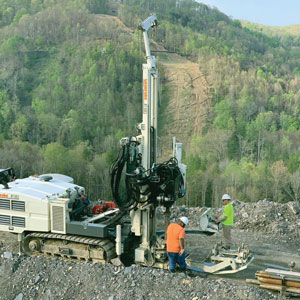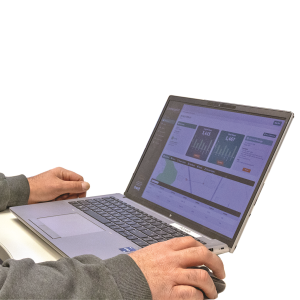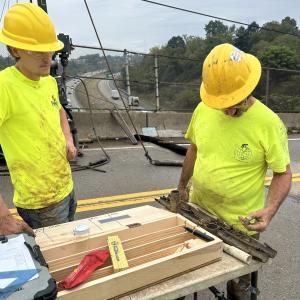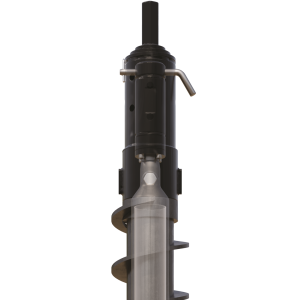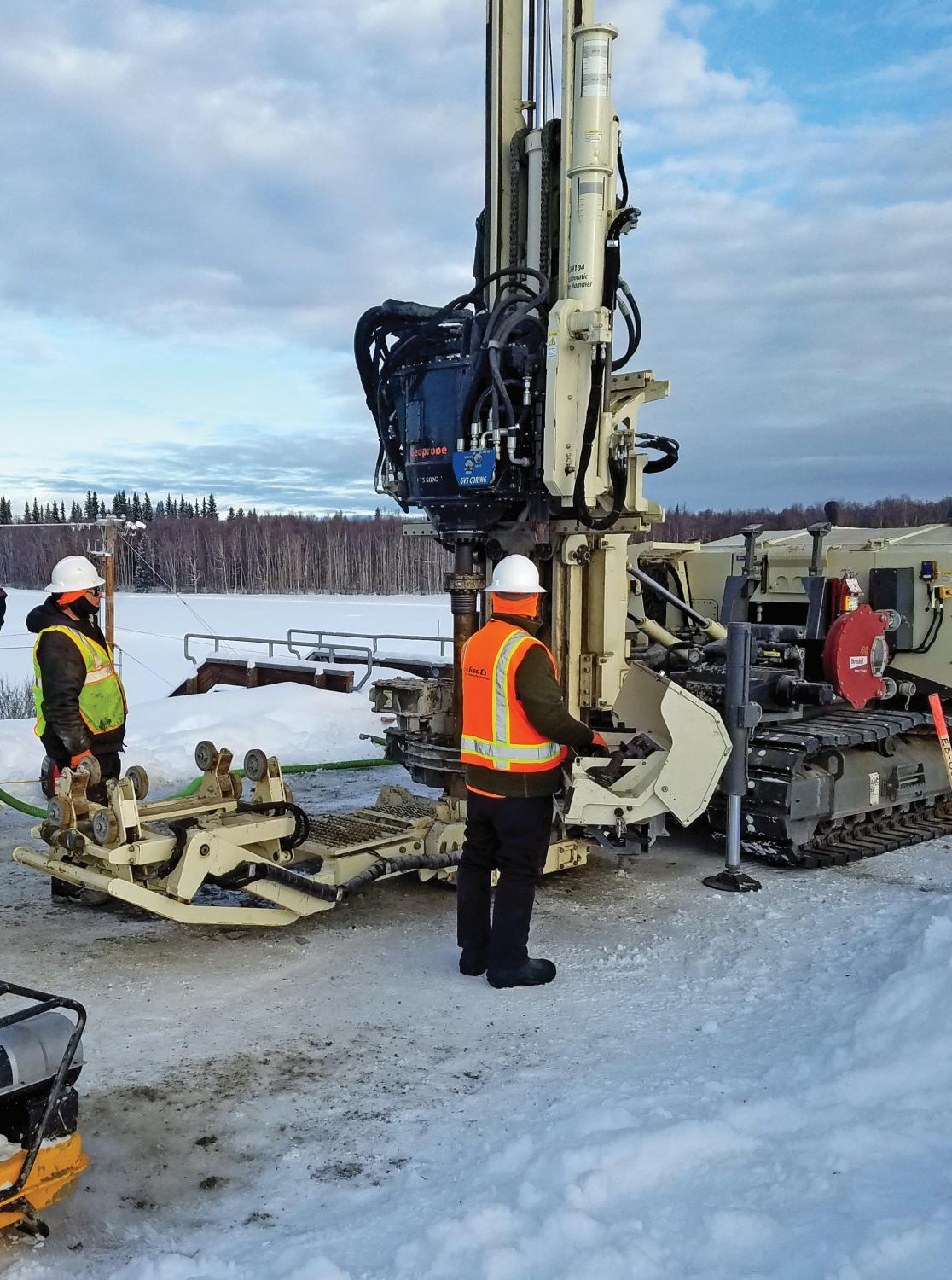
Past performance of Geoprobe® machines, tooling, and exceptional service led Discovery Drilling to choosing Geoprobe® sonic drill rigs.
Drillers today are looking for rigs that are not only powerful and reliable but also adaptable to a wide variety of conditions and applications.
“Our clients are facing increasingly complex drilling scenarios,” Doug Koehler, Geoprobe® sonic expert, explains. “Whether it’s drilling in urban environments with space constraints or tackling challenging geological formations, they need equipment that can adapt to their specific needs.”
What Is Sonic Drilling Used For
When Geoprobe® initially released their first sonic rigs, sonic drilling was used almost entirely on environmental sites where cased-hole soil and water sampling in difficult formations demanded a premium equipment and tooling solution.
“As our sonic rigs have become more robust, we now see sonic equipment going to a wide range of job sites,” Koehler said. “Customers now leverage sonic drilling for dewatering, exploration, water well, mining, construction, geothermal, geotechnical, and oil and gas.”
Sonic drilling is used at these sites for a variety of reasons. However, common needs include:
• completing the job regardless of subsurface conditions encountered
• casing a hole through difficult overburden
• removing the casing upon completion of work
• collecting high-quality soil, water, and rock samples
• using a wider range of casing sizes
As companies and governments around the world work to reduce their environmental impact, sonic technology also fulfills the demand for effective and eco-friendly drilling methods grows.
“Sonic drilling is inherently more sustainable than many traditional methods,” Koehler explains. “It uses less water, generates fewer cuttings, and can often achieve the same results with less energy. As environmental regulations become stricter, we expect to see even greater adoption of sonic technology.”
Sonic Use Strengthens Market Position
South Atlantic Environmental Drilling and Construction Company (SAEDACCO) in South Carolina, explored for several years how sonic drilling might fit their model and were concerned it might be too expensive for their customers. In the end, customer needs and evolving technology convinced them to invest.
“Customers were wanting better unconsolidated sample data. They needed more information from sonic to better map out projects and provide a better understanding of the lithology of the subsurface,” Pete Byer, president, said. “Sonic is another tool in the tool bag to help pinpoint where the next dollars are going to be spent on remediation. It actually helps save money on remediation.”
Adding sonic technology diversified their expertise and strengthened their market position.
“Our equipment covers a broad spectrum, as such, it’s challenging to have operators who are competent on every piece of equipment,” Byer said. “Having all types of drills — from direct push machines, auger, rotary, air and sonic drills — along with our extensive construction/remediation capabilities gives SAEDACCO a unique advantage in the marketplace.”
Bringing Sonic Services In-House
In the environmental drilling industry for two decades, Scott Densteadt has seen it come full circle.
“When I started, all we did was drill hollow stem auger or mud rotary. Then the direct push side of things really took off and became the standard. However, this limits achievable depths,” Densteadt said. “Now it's coming full circle with more requests for drilling, but you want to collect the best lithological data possible and hollow stem auger is a crude method.”
Recognizing sonic sampling provides a good lithological core every time, in half the time as hollow stem auger, the Remediation and Redevelopment Division of Michigan Department of Environment, Great Lakes, and Energy (EGLE) conducted a study comparing how much the state was paying outside contractors for sonic drilling services versus costs to add those services in-house.
“We determined we could do it ourselves for a cost savings,” said Densteadt, drilling supervisor for the geological service section. “We looked at other manufacturers, but our past positive working relationship and customer service along with a lower price point - enabling saving tax-payer money - steered the decision toward the Geoprobe® 8150LS.”
According to Densteadt, compared to hollow stem auger drilling, their 8150LS sonic rig has also:
• Saved time achieving depth,
• Reduced physical strain,
• Produced fewer spoils.
“Coming from hollow stem auger, sonic drilling is way better and faster, especially in difficult formations where high-quality sampling is a priority,” Densteadt said.
Sonic Use Reduces Dollar Per Foot
Throughout the years Geotek Alaska diversified their services to where they found themselves completing a 50/50 mix of environmental and geotechnical drilling. As the company has grown, they’ve sought opportunities to grow the technologies offered to clients — including sonic drilling.
"We initially rented an 8150LS for a job on an Air Force base in Fairbanks, drilling 2-inch wells to 220 feet from December through January in -30 degree weather,” Scott Vojta, president, said. “The 8150LS performed flawlessly in those temperatures. We had more problems with trucks and skid steers then we did the 8150.”
The crew sampled and set a well to 220 feet in a single shift then a second crew performed the surface completions and site preps.
“It was our first sonic project and it went well and completed under budget, and this was all possible because of the durability of the 8150 and the tooling,” Vojta said.
They wanted to purchase the rig then but were hesitant to spend that amount of money on a technology yet to be proven profitable in Alaska. But when Geoprobe® had an 8140LC in on trade, Vojta seized the opportunity to invest in sonic technology and understand where in their region sonic drilling vs rotary drilling made economic sense.
“For the soils in Fairbanks, it’s conducive to use sonic to get to depth. If rotary drilling, you potentially break your tool string or are not able to get cuttings to return to the surface and stall out. Direct push using an 8040 will meet refusal before depth is achieved. Thus you have to use a tricone bit to rotary wash and develop large amounts of investigation derived waste (IDW),” Vojta said. “Sonic technology can sample and set a well to 200 feet in a day. It’s extremely fast and collects a large sample. If you do the water correctly, there’s not a lot of IDW compared to rotary method.”
As they’ve been establishing their sonic footprint, they’ve come to realize sonic drilling vs rotary drilling or direct push can reduce the dollar per foot.
“Some people think sonic costs more to run, but cost wise per foot — when it works, it’s less,” Vojta said. “We’re building a solid foundation of where it will work and clients like it. Our piece of the pie is growing.”
Sonic Technology Adds Versatility
As sonic drilling demand in Alaska increased, Discovery Drilling determined they could no longer dismiss sonic technology as some passing fad.
“We began to do our own research, reaching out to others in our industry with experience in the realm of sonic drilling — specifically in similar geology to what we have here in Alaska,” DJ Wardwell, drilling manager, said.
Past performance of Geoprobe® machines, tooling, and exceptional service led them to choosing a Geoprobe® sonic drill rigs; seeing the 8150LS in action at the 2021 Geoprobe® Open House sealed the deal.
“Hearing feedback from other industry professionals and knowing the amount of research and development that goes into Geoprobe® machines made it an easy decision to pick the 8150LS for the first sonic drill to add to our fleet,” Wardwell said. “It is such an amazing, powerful platform, with everything we need in a single package ¬— including the capability for wireline rock coring and ability to collect SPT samples.”
Their 8150LS has certainly been working for them, exceeding their expectations in just about every aspect imaginable.
“Ease of use; ability to run large diameter 10-inch tools — hands-free; tooling options for about whatever geology we could encounter here in Alaska; ultimately the overall power of the machine are just a few things that come to mind,” Wardwell said. “We were convinced that it may struggle with some of the typical challenges we face in the subsurface here — like ice-rich permafrost or glacial till — but nothing seems to be able to stop this machine.”
Contact Us
1835 Wall Street
Salina, Kansas 67401
Phone: (785) 825-1842
Related Articles
Geoprobe® Introduces Drill Rig Telemetry to the Drilling Industry — monitor rig operations easily through our customer portal, Centerpoint Connected.
ID: 14625 | Date:
Rig service technicians work quickly to make precise repairs, knowing downtime affects the business.
ID: 14622 | Date:
Service technicians offer onsite repairs or over the phone troubleshooting.
ID: 14621 | Date:
Geoprobe® interlocking split spoons meet the demands of geotechnical drillers using conventional rigs.
ID: 14620 | Date:
The 4.25 HSA Continuous Sampler is versatile and easy to use when collecting large sample volumes.
ID: 14619 | Date:
Related Videos
ID: 14189


